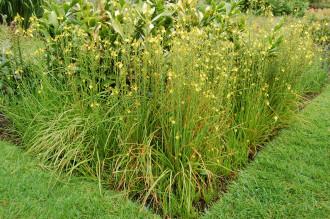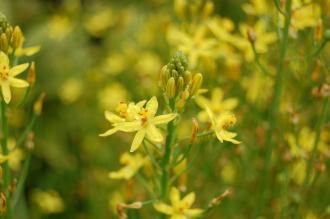
Bulbine bulbosa (07/06/2014, Kew Gardens, London)
Position: Full sun to dappled shade
Flowering period: Early summer
Soil: Moist well drained
Eventual Height: 60cm
Eventual Spread: 35cm
Hardiness: 8a, 8b, 9a, 9b, 10a, 10b, 11
Family: Xanthorrhoeaceae
Sub Family: Asphodeloideae
Bulbine bulbosa is a deciduous perennial with a clump forming, upright habit. Its grey/ green leaves are narrowly lanceolate emerge from the base of the stem, up to 40cm long and 2cm broad. Its fragrant yellow flowers are star shaped, up to 2cm across, appear on vertical flower stalks, with the oldest flowers at the bottom. Each flower lasts one day. Its fleshy roots emerge from a corm at its base.
Bulbine bulbosa, commonly known as Bulbine Lily, Golden Lily, Leek Lily and Yellow Onion Weed, is native to east temperate Australia. In its native habitat it grows in dry forests and meadows and areas which become wet in the winter months.
The etymological root of the binomial name Bulbine is derived from the Latin meaning ‘a kind of bulbous plant’. Bulbosa is from the Latin meaning ‘having bulbs’.
The landscape architect may find Bulbine bulbosa useful as part of a perennial planting scheme, particularly when planted en mass. It is also suitable for prairie type planting schemes.

Bulbine bulbosa Flower (07/06/2014, Kew Gardens, London)
Ecologically, Bulbine bulbosa flowers are attractive to pollinating insects.
Bulbine bulbosa prefers moist, fertile, well-drained soils. It tolerates most pH of soil. It will tolerate poor soils.
Bulbine bulbosa requires little maintenance. Large clumps may be divided after flowering.

